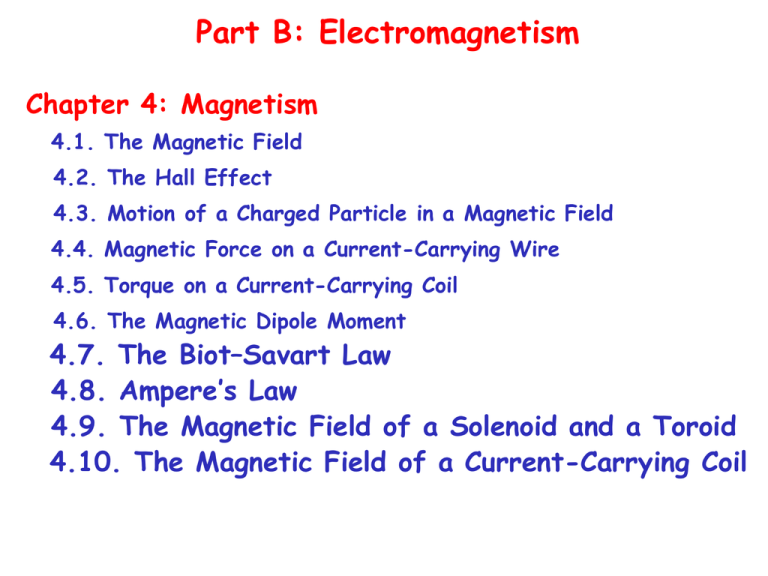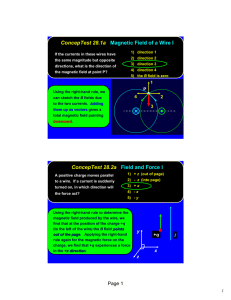Lecture 12
advertisement

Part B: Electromagnetism Chapter 4: Magnetism 4.1. The Magnetic Field 4.2. The Hall Effect 4.3. Motion of a Charged Particle in a Magnetic Field 4.4. Magnetic Force on a Current-Carrying Wire 4.5. Torque on a Current-Carrying Coil 4.6. The Magnetic Dipole Moment 4.7. The Biot–Savart Law 4.8. Ampere’s Law 4.9. The Magnetic Field of a Solenoid and a Toroid 4.10. The Magnetic Field of a Current-Carrying Coil Overview In this lecture, we study magnetic fields produced by a moving charged particle or a current. This feature of electromagnetism is the combination of electric and magnetic effects and it has become extremely important because of its application in our life 4.7. The Biot–Savart Law (Calculating the Magnetic Field Due to a Current): Problem: We need to calculate the magnetic field B at point P due to a current Method: We use the same principle as used to calculate the electric field due to a charge distribution: • We divide (mentally) the wire into differential elements ds ids • A differential current-length element • From experiments, the field dB 0 ids sin dB 4 r 2 where : is the angle between ds and r 0 : is the permeability constant 7 6 0 4 10 T .m / A 1.26 10 T .m / A The Biot-Savart law: 0 ids r dB 4 r 3 We will use the law above to calculate the magnetic field at a point due to various distributions of current 4.7.1. Magnetic Field Due to a Current in a Long Straight Wire: 0 ids sin dB 4 r 2 we calculate the B field due to the upper half of the wire as shown, the total B is: 0i sin ds B 2 dB 2 2 r 0 0 We also have: r s R sin sin( ) 2 2 R s2 R2 0i Rds B 2 ( s 2 R 2 ) 3 / 2 0 (see Appendix E for the integral) 0i B 2R Animation To determine the B direction, we use the right hand rule: Grasp the element in your right hand with your extended thumb pointing in the direction of the current. Your fingers will then naturally curl around in the direction of the magnetic field lines due to that element Iron filings that have been sprinkled onto cardboard collect in concentric circles when current is sent through the central wire 4.7.1. Magnetic Field Due to a Current in a Circular Arc of Wire: Problem: Find the magnetic field produced at a point by a current in a circular arc of wire Method: We calculate the field produced by a single current-length element, then integrate to find the net field by all the elements Example: An arc-shaped wire with angle , radius R, current i with = 900: 0 ids sin 0 ids dB 4 r 2 4 R 2 with ds = Rd: 0 iRd 0i B dB d 4 R 2 4R 0 0 • So, the magnitude of the field produced by a circular arc of wire: 0i B 4R • For a full circle, the field at the center: 0i 2 0i B 4R 2R Note: To determine the direction of the magnetic field, we use the right-hand rule Checkpoint: The figure shows three circuits consisting of straight radial lengths and concentric circular arcs (either half- or quartercircles of radii r, 2r, and 3r). The circuits carry the same current. Rank them according to the magnitude of the magnetic field produced at the center of curvature (the dot), 1 greatest first 1 1 0i B 4R (a) (b) (c) 2 2 0i 0i 0i B B1 B2 4 3r 4r 3r 0i 0i 0i B B2 B1 4r 4 3r 6r B B1 B2 B3 0i 0i 0i 130i B 4 3r 4 2r 2 4r 2 48r Rank: a, c, b 2 3 Magnetic Field Due to Brain Activity Animation • In a typical pulse: i = 10 A • The conducting path length: 1 mm • Point P at r = 2cm • Angle = 900 The magnetic fields detected in MEG (magneto-encephalo-graphy), a procedure to monitor the human brain, are probably produced by pulses (e.g., when reading) along the walls of the fissures (crevices) on the brain surface: (4 10 7 T .m / A) (10 10 6 A)(110 3 m) dB sin 900 2.5 10 12T 4 (2 10 2 m) 2 to measure such a very small field, we need to use an instrument called SQUIDs (Superconducting Quantum Interference Devices) 4.7.2. Force Between Two Parallel Currents: Problem: Two long parallel wires carrying currents exert forces on each other. Calculate those forces The field Ba produced by current a at the site of wire b: 0 ia Ba 2d So, the force F acting on b from a: Fba ib L Ba Bb Fab ba The magnitude: 0 Lia ib Fba ib LBa sin 90 2d 0 • Applying the same steps, we can also calculate Bb at current a and Fab acting on current a is shown in the figure these forces pull the currents close to each other • If the two currents are antiparallel, the forces push the currents apart Rail Gun: An application is based on the B field produced by two antiparallel currents: • Conducting fuse (e.g., a piece of copper) will melt and vaporize after the current passes through it, creating a conducting gas • The magnetic field produced by the two currents are directed downward between the rails • The field exerts a force on the gas, which is forces outward along the rails and thus the gas pushes the projectile Example: A projectile of 5 tonnes (5000 kg) can be accelerated to a speed of 10 km/s within 1 ms Rail Gun Test Fire Checkpoint: The figure shows three long, straight, parallel, equally spaced wires with identical currents either into or out of the page. Rank the wires according to the magnitude of the force on each due to the currents in the other two wires, greatest first. Fac Bc Bb Ba Fba Fab F bc The net force acting on curent b: For a: For c: Bc Ba Bb Fcb Fca 2 0 Lia ib 0 Lic ib 0 Li Fb Fba Fbc 2 2d 2d 2d 0 Lia ib 0 Licib 0 Li 2 1 Fa Fab Fac 2d 2 2d 2d 2 0 Lia ib 0 Lic ib 0 Li 2 3 Fc Fcb Fca 2d 2 2d 2d 2 4.8. Ampere’s Law: • In the previous chapter, we use Gauss’ law to determine the net electric field due to some symmetric distributions of charges (planar, cylindrical, spherical symmetry) • Here, to determine the net magnetic field due to some symmetric distributions of currents we use Ampere’s law: Bds 0ienc where ienc is the net current encircled in the Amperian loop • To apply Ampere’s law: o Arbitrarily choose the direction of integration o Arbitrarily assume B to be generally in the direction of integration o Use the curled-straight right-hand rule (see the next slide) to assign a plus sign or a minus sign to each of the currents The curled-straight right hand rule: Curl your right hand around the Amperian loop, with the fingers pointing in the direction of integration. A current through the loop in the general direction of your outstretched thumb is assigned a plus sign, and a current generally in the opposite direction is assigned a minus sign ienc i1 i2 B cos ds 0ienc 0 (i1 i2 ) Question: Why current i3 contributes to the B field magnitude on the left side of the equation above but i3 is not in the right side? Because its contributions to the B field cancel out as the integration is made around a closed loop. In contrast, the contributions of an encircled current to the magnetic field do not cancel out 4.8.1. The Magnetic Field Outside a Long Straight Wire with Current: Here, we use Ampere’s law to find the B field at a point outside and produced by a long, straight wire. The direction of integration is counterclockwise: B cos ds B ds B(2r ) Using the right-hand rule, the current i is positive: so, we obtain: B(2r ) 0i 0i B 2r This is the field that we derived using the Biot-Savart law, but here the calculation is quite simple 4.8.2. The Magnetic Field Inside a Long Straight Wire with Current: We use Ampere’s law to find the B field inside a long, straight wire with current. The direction of integration is counterclockwise: B cos ds B ds B(2r ) If the current is uniformly distributed: ienc i r 2 R 2 r 2 0i r B(2r ) 0i B 2 2 R 2R so, we obtain: So, B = 0 at the center and maximum at the surface 4.9. The Magnetic Field of a Solenoid and a Toroid: 4.9.1. Magnetic Field of a Solenoid: Solenoid: A long, tightly wound helical coil of wire The magnetic field produced by a solenoid carrying current i is shown: the field is strong and uniform at interior points but relatively weak at external points A vertical cross section through the central axis of a current-carrying solenoid The field direction along the solenoid axis is determined by the curled-straight right-hand rule Calculate the magnitude of the magnetic field inside an ideal solenoid: Ampere’s law: b c Bds Bds Bds d Bds 0ienc c a b a Bds Bds Bh 0 0 0 Bh d For external points of an ideal solenoid: B = 0, so the third integral c d is zero ienc i(nh) where n is the number of turns per unit length B 0in 4.9.2. Magnetic Field of a Toroid: Toroid: It is a solenoid curved until its two ends meet The field inside a toroid can be calculated using Ampere’s law. We choose an Amperian loop as shown and the direction of integration is clockwise: B2r 0ienc 0iN N: the total number of turns 0iN 1 B 2 r So, the field in a toroid is not uniform like a solenoid, B ~ 1/r The direction of magnetic fields is also given by the curled-straight right-hand rule Animation 4.10. The Magnetic Field of a Current-Carrying Coil: Recall: A current-carrying coil behaves as a magnetic dipole, if we place it in an external magnetic field Bext, a torque acting on it: B NiA N: the number of turns of the coil Magnetic field of a Coil: The field at a point on the central axis of the coil: B( z ) 0iR 2 2( R 2 z 2 ) 3 / 2 (1) if z >> R: B( z ) 0iR 2 2z 3 Animation For a coil of N turns and A is the area of the loop: B( z ) B and 0 NiA 3 2z have the same direction 0 B( z ) 2 z 3 So, we have 2 ways to consider a current-carrying coil as a magnetic dipole: (1) it experiences a torque in an external magnetic field (2) it generates its own intrinsic magnetic field, acting as a magnet Homework: Read proof of equation (1) Homework: 4, 7, 12, 16, 18, 22, 35, 38, 43, 46, 49, 50, 57, 62 (pages 783-788)



